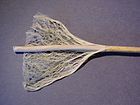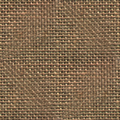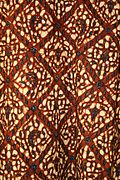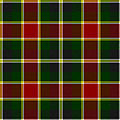- Spandex
-
Spandex or elastane is a synthetic fibre known for its exceptional elasticity. It is strong, but less durable than natural Latex, its major non-synthetic competitor. It is a polyurethane-polyurea copolymer that was co-invented in 1959 by chemists C. L. Sandquist and Joseph Shivers at DuPont's Benger Laboratory in Waynesboro, Virginia. When first introduced, it revolutionized many areas of the clothing industry.
The name "spandex" is an anagram of the word "expands".[1] It is the preferred name in North America; in many European countries it is referred to as "elastane", and is known in Britain mainly as LYCRA. Brand names for spandex include LYCRA (made by INVISTA, previously a part of DuPont), ELASPAN (also INVISTA's), Creora (Hyosung), ROICA and Dorlastan (Asahi Kasei), Linel (Fillattice), and ESPA (Toyobo).
Contents
Spandex fibers production
Spandex fibers are produced in four different ways: melt extrusion, reaction spinning, solution dry spinning, and solution wet spinning. All of these methods include the initial step of reacting monomers to produce a prepolymer. Once the prepolymer is formed, it is reacted further in various ways and drawn out to make the fibers. The solution dry spinning method is used to produce over 94.5% of the world's spandex fibers.[2]
Solution dry spinning
Step 1: The first step is to produce the prepolymer. This is done by mixing a macroglycol with a diisocyanate monomer. The two compounds are mixed together in a reaction vessel to produce a prepolymer. A typical ratio of glycol to diisocyanate is 1:2.[2]
Step 2: The prepolymer is further reacted with an equal amount of diamine. This reaction is known as chain extension reaction. The resulting solution is diluted with a solvent to produce the spinning solution. The solvent helps make the solution thinner and more easily handled, and then it can be pumped into the fibre production cell.
Step 3: The spinning solution is pumped into a cylindrical spinning cell where it is cured and converted into fibres. In this cell, the polymer solution is forced through a metal plate called a spinneret. This causes the solution to be aligned in strands of liquid polymer. As the strands pass through the cell, they are heated in the presence of a nitrogen and solvent gas. This process causes the liquid polymer to react chemically and form solid strands.[2]
Step 4: As the fibres exit the cell, an amount of solid strands are bundled together to produce the desired thickness. Each fibre of spandex is made up of many smaller individual fibres that adhere to one another due to the natural stickiness of their surface.[2]
Step 5: The resulting fibres are then treated with a finishing agent which can be magnesium stearate or another polymer. This treatment prevents the fibres' sticking together and aids in textile manufacture. The fibres are then transferred through a series of rollers onto a spool.
Step 6: When the spools are filled with fibre, they are put into final packaging and shipped to textile manufacturers.
Major spandex fibre uses
- Apparel and clothing articles where stretch is desired, generally for comfort and fit, such as:
- athletic, aerobic, and exercise apparel
- belts
- bra straps and side panels
- competitive swimwear
- dance belts worn by male ballet dancers and others
- diapers
- disco jeans
- gloves
- hosiery
- leggings
- netball bodysuits
- orthopaedic brace
- ski pants
- skinny jeans
- slacks
- socks
- swimsuits/bathing suits
- underwear
- wetsuits
- zentai
- Compression garments such as:
- cycling shorts
- foundation garments
- motion capture suits
- rowing unisuit
- Shaped garments such as bra cups
- support hose
- surgical hose
- superhero
- women's volleyball shorts
- wrestling singlet
- Home furnishings, such as microbead pillows
For clothing, spandex is usually mixed with cotton or polyester, and accounts for a small percentage of the final fabric, which therefore retains most of the look and feel of the other fibers. In North America it is rare in men's clothing, but prevalent in women's.
See also
References
External links
Fibers Natural Mineral
Synthetic CelluloseMineralClothing Materials Tops Blouse · Crop top · Dress shirt · Halterneck · Henley shirt · Hoodie · Jersey · Guernsey · Poet shirt · Polo shirt · Shirt · Sleeveless shirt · Sleeveless sweater · Sweater · T-shirt · Tube top · Turtleneck · TwinsetTrousers or pants Bell-bottoms · Bermuda shorts · Bondage pants · Capri pants · Cargo pants · Culottes · Cycling shorts · Dress pants · Jeans · Jodhpurs · Overall · Parachute pants · Phat pants · Shorts · Sweatpants · WindpantsSkirts A-line skirt · Ballerina skirt · Fustanella · Hobble skirt · Jean skirt · Job skirt · Leather skirt · Kilt · Men's skirts · Microskirt · Miniskirt · Pencil skirt · Poodle skirt · Prairie skirt · Rah-rah skirt · Sarong · Skort · Slip · Train · WrapDresses Ball gown · Cocktail dress · Débutante dress · Evening gown · Gown · Jumper dress · Little black dress · Petticoat · Sari · Sundress · Tea gown · Wedding dress · Wrap dressSuits and uniforms Academic dress · Afrocentric suit · Black tie · Buddhist monastic robe · Clerical clothing · Court dress · Gymslip · Jumpsuit · Lab coat · Lounge suit · Mao suit · Morning dress · Pantsuit · Red Sea rig · Scrubs · Stroller · Tangzhuang · Tuxedo · White tieOuterwear Abaya · Academic gown · Anorak · Apron · Blazer · Cagoule · Cloak · Coat · Duffle coat · Duster · Frock coat · Jacket · Greatcoat · Leather jacket · Goggle jacket · Hoodie · Opera coat · Overcoat · Pea coat · Poncho · Raincoat · Redingote · Robe · Shawl · Shrug · Ski suit · Sleeved blanket · Sports coat · Top coat · Trench coat · Vest · Waistcoat · WindbreakerUnderwear Boxer briefs · Boxer shorts · Brassiere · Briefs · Bustle · Compression sportswear · Corselet · Corset · Diaper · Dickey · Lingerie · Loincloth · Long underwear · Panties · Teddy · Temple garment · Trunks · Undershirt · IzaarAccessories Ascot tie · Belly chain · Belt · Bolo tie · Bow tie · Chaps · Coin purse · Cufflink · Earring · Gaiters · Gloves · Hairpin · Handbag · Leg warmer · Leggings · Muff (handwarmer) · Necklace · Necktie · Scarf · Shoe buckle · Stocking · Sunglasses · Suspenders · TightsFootwear Athletic shoe · Boot · Court shoe · Dress shoe · Flip-flops · Hosiery · Sandal · Shoe · Slipper · SockHeadwear Nightwear Swimwear Bikini · Boardshorts · One-piece · Square leg suit · Swim briefs · Swim cap · Swim diaper · Swim trunks · WetsuitClothing parts Back closure · Buckle · Bustline · Button · Buttonhole · Collar · Cuff · Elastic · Fly · Hemline · Hook-and-eye · Lapel · Neckline · Pocket · Revers · Shoulder pad · Shoulder strap · Sleeve · Snap · Strap · Velcro · Waistline · ZipperNational costume Albanian dress · Abaya · Aboyne dress · Áo bà ba · Áo dài · Áo tứ thân · Batik · Baro't saya & Barong Tagalog · Bunad · Þjóðbúningurinn · Cheongsam (Qípáo) · Dashiki · Deel · Dhoti · Dirndl · Djellaba · Fustanella · Gákti · Gho & Kira · Han Chinese clothing · Hanbok · Highland dress · Jellabiya · Jilbāb · Kebaya · Kente cloth · Kilt · Kimono · Lederhosen · Sampot · Sarafan · Sari · Sarong · Shalwar kameez · Sherwani · ThawbHistorical garments Banyan · Bedgown · Bodice · Braccae · Breeches · Breeching · Brunswick · Caraco · Chemise · Cravat · Chiton · Chlamys · Close-bodied gown · Doublet · Exomis · Farthingale · Frock · Himation · Hose · Houppelande · Jerkin · Justacorps · Knickerbockers · Palla · Peplos · Polonaise · Sack-back gown · Smock-frock · Stola · Toga · TunicHistory and surveys See also Adaptive clothing · Clothing terminology · Costume · Dress code · Fashion · Formal wear · Ironing · Laundry · Locking clothing · Maternity clothing · Reversible garmentCategories:- 1959 introductions
- 1970s fashion
- 1980s fashion
- Copolymers
- Synthetic fibers
- Technical fabrics
- Woven fabrics
- Apparel and clothing articles where stretch is desired, generally for comfort and fit, such as:
Wikimedia Foundation. 2010.






